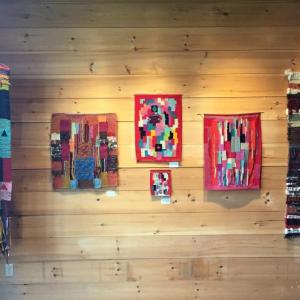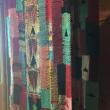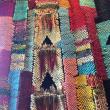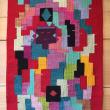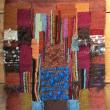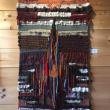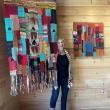Ancestral connection through weaving
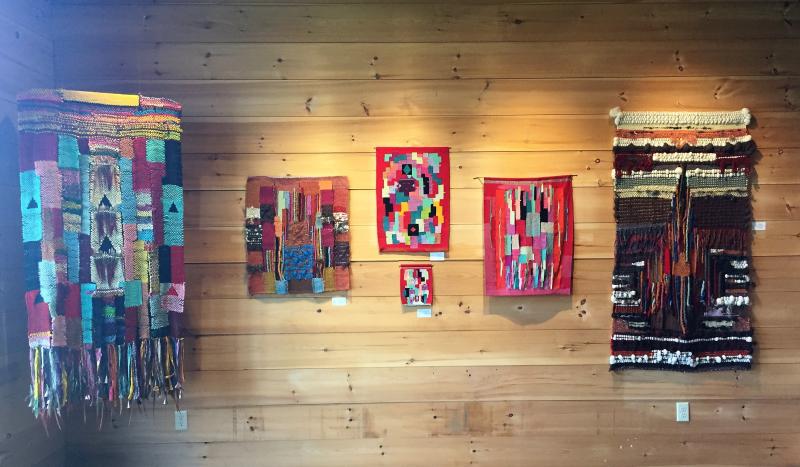 The Priscilla May Alden tapestry show at Down East Gallery in Edgecomb is on exhibit until the season’s end. LISA KRISTOFF/Boothbay Register
The Priscilla May Alden tapestry show at Down East Gallery in Edgecomb is on exhibit until the season’s end. LISA KRISTOFF/Boothbay Register
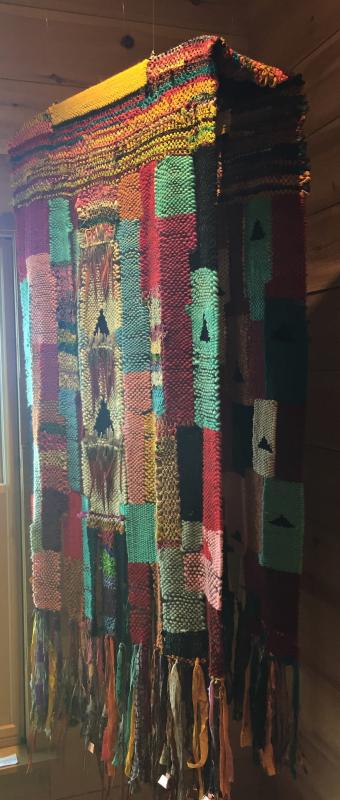 Ceremonial Dress - 96” - H, 36” - W. 14” - D. This stunning example of fiber art by Priscilla Alden is woven of wool and silk, accented with pheasant feathers and brass bells.
Ceremonial Dress - 96” - H, 36” - W. 14” - D. This stunning example of fiber art by Priscilla Alden is woven of wool and silk, accented with pheasant feathers and brass bells.
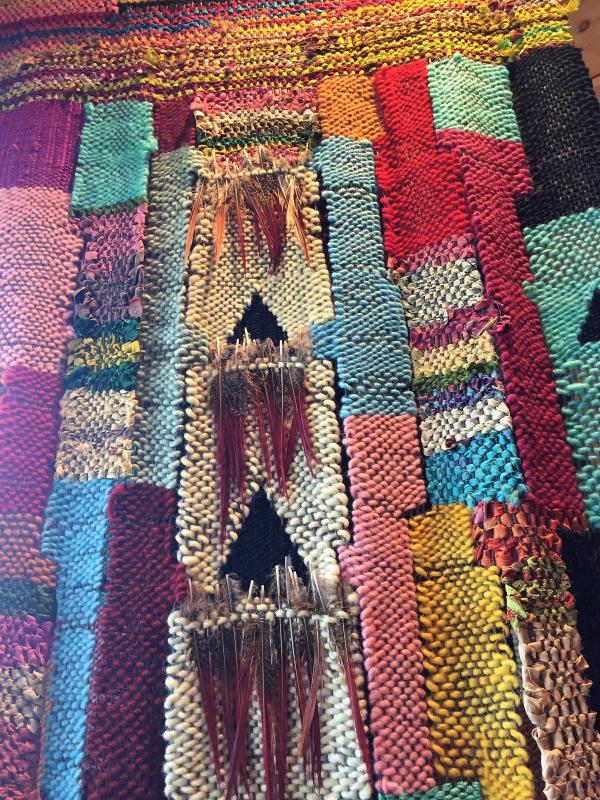 Close up of Priscilla Alden’s “Ceremonial Dress.”
Close up of Priscilla Alden’s “Ceremonial Dress.”
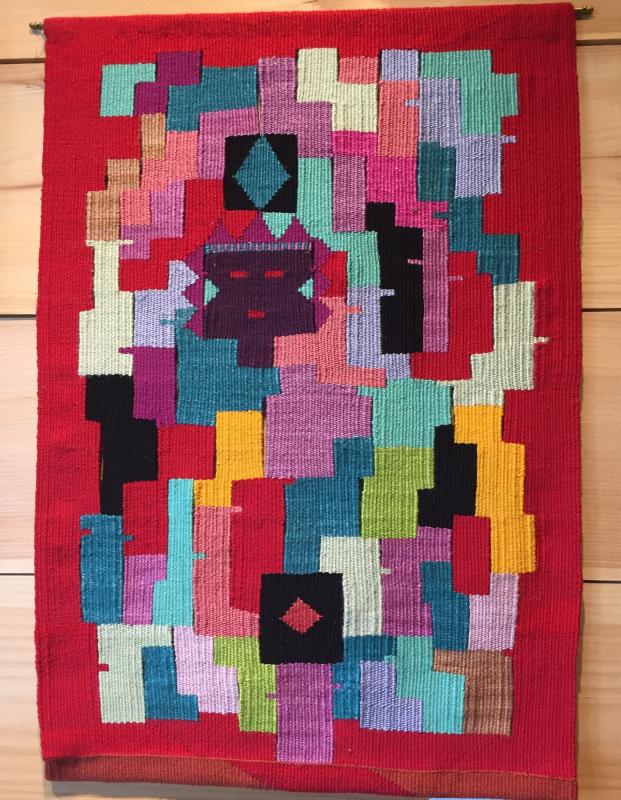 “Spirit Woman”: 28” x 18” - 28”x 18’ - cotton seine warp and silk weft woven by Priscilla Alden.
“Spirit Woman”: 28” x 18” - 28”x 18’ - cotton seine warp and silk weft woven by Priscilla Alden.
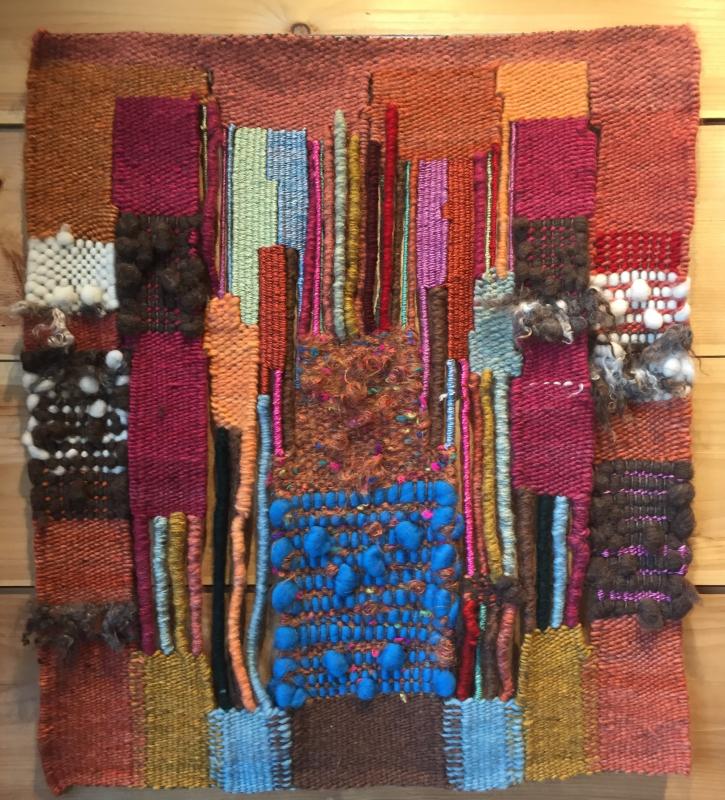 “Earth Daughter,” a wool warp, wool and silk weft creation by Priscilla Alden, is 28” x 26.”
“Earth Daughter,” a wool warp, wool and silk weft creation by Priscilla Alden, is 28” x 26.”
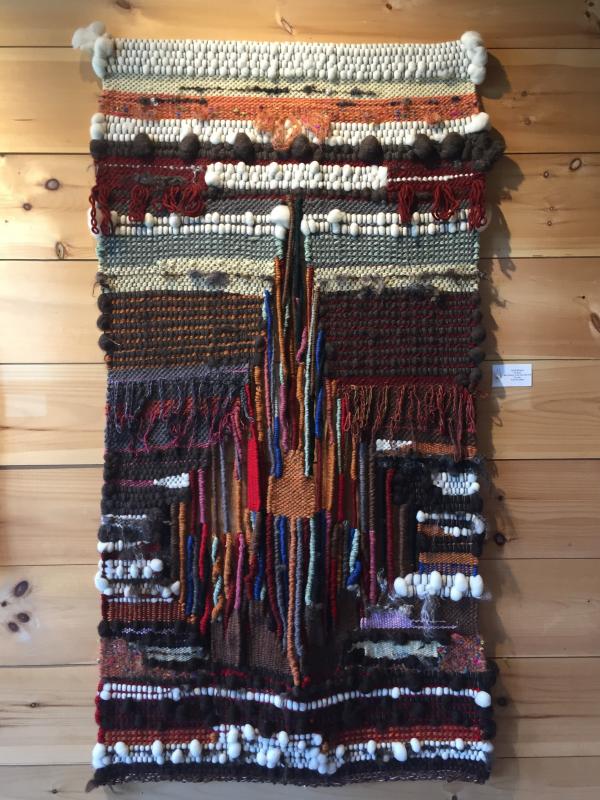 “Earth Mother.” Priscilla Alden. 64” x 35” - wool warp, wool and silk weft.
“Earth Mother.” Priscilla Alden. 64” x 35” - wool warp, wool and silk weft.
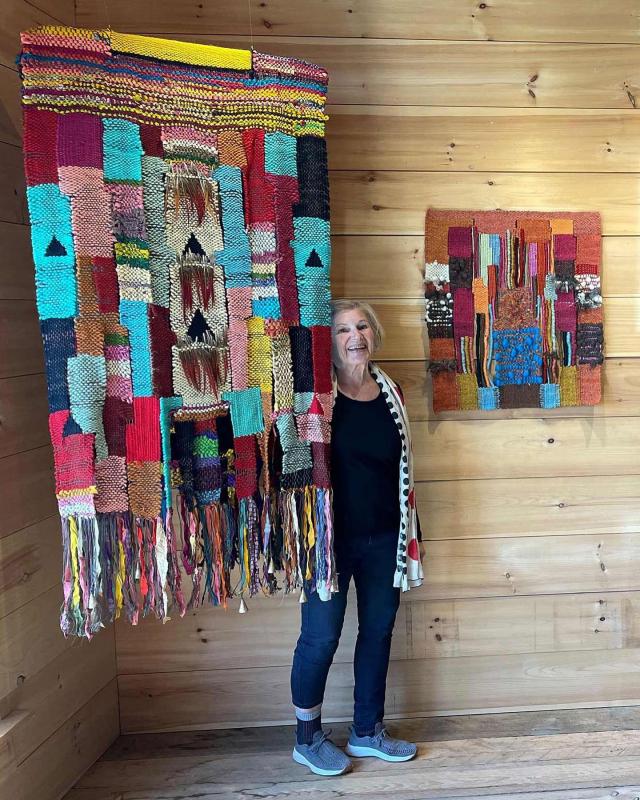 Priscilla May Alden and “Ceremonial Dress.” Courtesy of the gallery
Priscilla May Alden and “Ceremonial Dress.” Courtesy of the gallery
 The Priscilla May Alden tapestry show at Down East Gallery in Edgecomb is on exhibit until the season’s end. LISA KRISTOFF/Boothbay Register
The Priscilla May Alden tapestry show at Down East Gallery in Edgecomb is on exhibit until the season’s end. LISA KRISTOFF/Boothbay Register
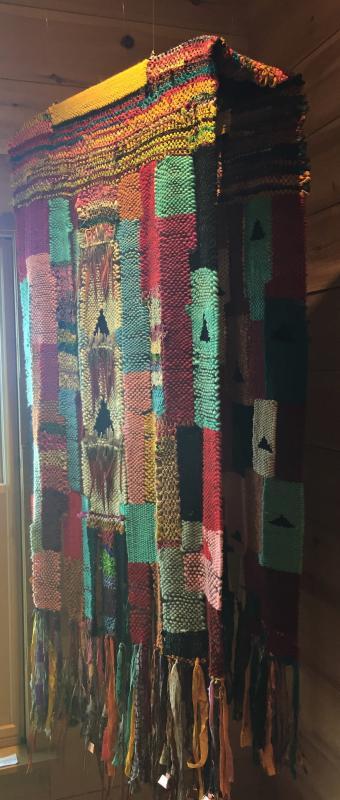 Ceremonial Dress - 96” - H, 36” - W. 14” - D. This stunning example of fiber art by Priscilla Alden is woven of wool and silk, accented with pheasant feathers and brass bells.
Ceremonial Dress - 96” - H, 36” - W. 14” - D. This stunning example of fiber art by Priscilla Alden is woven of wool and silk, accented with pheasant feathers and brass bells.
 Close up of Priscilla Alden’s “Ceremonial Dress.”
Close up of Priscilla Alden’s “Ceremonial Dress.”
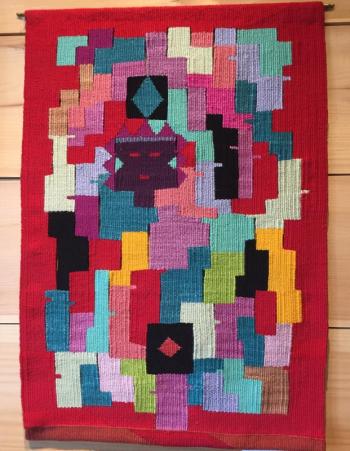 “Spirit Woman”: 28” x 18” - 28”x 18’ - cotton seine warp and silk weft woven by Priscilla Alden.
“Spirit Woman”: 28” x 18” - 28”x 18’ - cotton seine warp and silk weft woven by Priscilla Alden.
 “Earth Daughter,” a wool warp, wool and silk weft creation by Priscilla Alden, is 28” x 26.”
“Earth Daughter,” a wool warp, wool and silk weft creation by Priscilla Alden, is 28” x 26.”
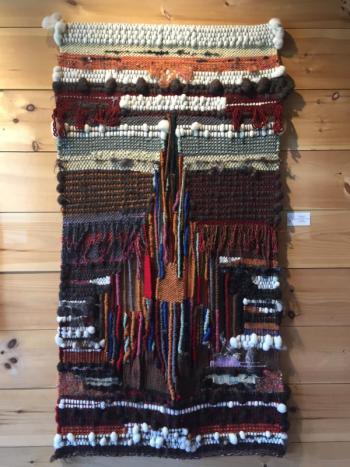 “Earth Mother.” Priscilla Alden. 64” x 35” - wool warp, wool and silk weft.
“Earth Mother.” Priscilla Alden. 64” x 35” - wool warp, wool and silk weft.
 Priscilla May Alden and “Ceremonial Dress.” Courtesy of the gallery
Priscilla May Alden and “Ceremonial Dress.” Courtesy of the gallery
I’ve written about the tapestries of Priscilla May Alden a few times over the past nine or 10 years. And there’s a reason for that: I love her art and I love to write about it. All that warp (vertical threads) and weft (horizontal threads) … plus, I always learn something.
And what fascinates me about women and men who dig expressing themselves throught this art form is that they make their canvases, warp after warp over the years, the platform for designs, patterns and some that are full-on paintings of land and seascapes; others become portraits and even corsets! Be in awe.
Watching Cilla weave from time to time, I’ve observed the easy rhythm between artist and loom. And in the end, it’s the energy created in this union that draws us in to the finished tapestry.
Cilla has been the spotlight show over at Brad Betts’ Down East Gallery. “Powerful Women” is composed of five tapestries she chose because of the story each tells individually, and particularly, together. You can find them on the right wall of the stage in the barn.
First off there’s her gorgeous, and I mean gorgeous, sculptural piece, “Ceremonial Dress,” “Earth Mother,” “Earth Daughter I” and “Earth Daughter II,” “Spirit Woman” and “Spirit Women.”
If you missed seeing “Ceremonial Dance” when it was first shown at Studio 53 in 2016 or 2017 in the show “Ancient Flow,” that also featured the stone sculpture (and more) of Cilla’s husband, Dick Alden, the time is now.
At Down East Gallery, “Ceremonial Dress” (96”H-36”W-14”D) is of wool, silk, pheasant feathers and brass bells with areas of open and loose weave. It’s hung like an open poncho, from a beam on the barn ceiling to allow viewers to experience it from inside looking out. One thing I can tell you for certain: There’s palpable energy in there!
This tapestry is sure to remind you of the clothing a woman would wear during a ritual of celebration or petition. Cilla has studied weaving with Navajo women during trips to the Southwest. Back in 2013, she invited Master Navajo Weaver Jennie Slick, and Mary Walker, interpreter and storyteller of Navajo weavers, to Boothbay Harbor. There were a couple talk/demos at Studio 53 (Cilla and Dick were members there) and two one-week workshops with Jennie Slick. Recalled Cilla, “Both of the workshops were full. Weavers came from all over – Connecticut, Massachusetts, Maine … I can’t remember where else now. It was wonderful.” Sure it was – how often does the opportunity to study Navajo weaving with someone like Jennie Slick come along?
“I remember going to the Pueblos and seeing the women dancing to the beating of drums, almost in a trance. It was so strong and powerful … I felt connected to them, their heritage, and ancestors,” Cilla said.
Remember when I said I learn something? Here’s what that was this time: Cilla said she’d been reading a lot about the Bauhaus and Anni Albers in Albers’ seminal book on this art form entitled, “On Weaving.”
What? Who? Right, I was curious, too. Here’s a combination of what she explained to me and what I dug up. I just can’t help myself from doing it – from a few Google searches and an essay on The Met’s website: German architect Walter Gropius founded the (Staatliches) Bauhaus (1919-1933) to “reimagine the material world to reflect the unity of all the arts.”
Fine arts, crafts and design were combined under the roof of the Bauhaus. Albers went from being a student in its weaving workshop to a teacher of weaving design theory to moving to the U.S. and the Black Mountain College in North Carolina where she was the director of weaving studies. There’s more, but you can look it up. too.
“I just love the work, its geometric shapes and tight weaving,” Cilla said. “The colors. When I look at ‘Spirit Woman’and ‘Spirit Women’ I see I was influenced by Bauhaus design without being aware of it at the time.”
The Bauhaus also encouraged the use of unusual materials. This Cilla did with the bells and pheasant plumes.
My other absolute fave piece in the show is “Earth Mother.” This tapestry’s dimensions are 64” x 35,” the wool and silk weft woven on a wool warp. There are so many textures woven in, open areas, pom-pom tufts material, fringe, open loops … just as the Earth is comprised of many elements and civilizations, all are rooted in her and can be seen in the various weaves within this tapestry.
For some artists, last year was a productive one, a way to cope with the pandemic and express how it was affecting them. For others … not so much, and this is where Cilla found herself.
“I didn’t do a lot all last fall and winter … I just didn’t have the energy during COVID. But I did do a landscape piece at home this spring on a vertical loom of ledges and a tidal pool on Shore Road from a photo. And I just finished a Pueblo working on my big (Spanish walking) loom with more color blocks like the ones in ‘Spirit Woman’ and ‘Spirit Women’ and it was as tightly woven.”
The good news for all of us Priscilla May Alden fans is there are new, more experimental tapestries sketched out – experimental in colors as well as weaving techniques. And that is rockin’ good news! For now though, you must see “Powerful Women” on exhibit until the end of the season … maybe early October-ish? Put this gallery on your list this month!
There are also shows at Down East Gallery of works by Andre Benoit and Brad Betts going on now, as well as Mike Lewis Museum, and sculptures. You’ll find it at 146 Boothbay Road/Route 27 in Edgecomb.
FMI on the gallery in the 1906 farmhouse and the post and beam barn, visit www.downeastgallery.com and, for more about the powerful woman, visit www.priscillamayalden.com
Event Date
Address
146 Boothbay Road
Edgecomb, ME 04544
United States

